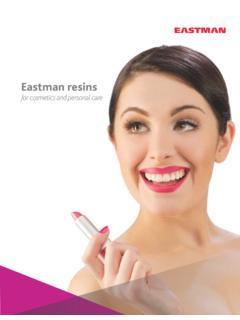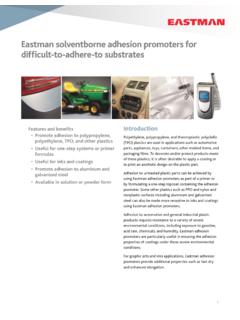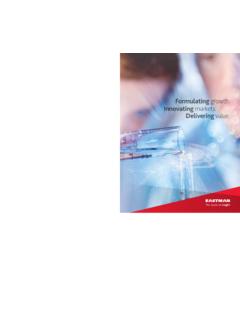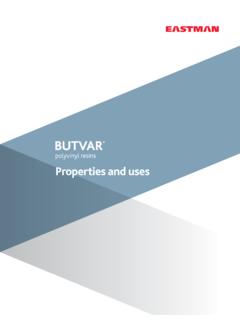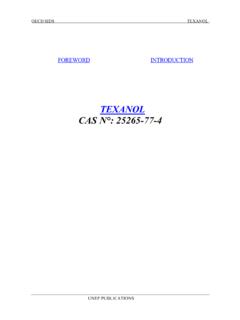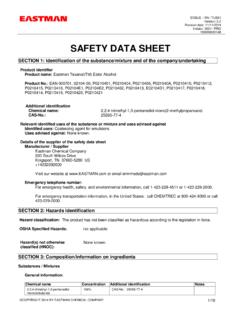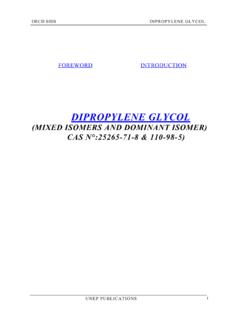Transcription of Standing the test of time - eastman.com
1 Standing the test of timeEastman Texanol ester alcohol The premier coalescent2 ContentsTimeless eastman Texanol ester alcohol 3 Regulatory and environmental 3 Other uses 3 The benefits of coalescent 4 Scrub resistance 4 Low-temperature coalescence 5 Color development 5 Advantages of using eastman Texanol ester alcohol 6 Associative thickener efficiency 6 Water solubility 7 Hydrolytic stability 7 Compatibility 8 Shocking 8 Evaporation rate 9 Non-yellowing properties 9 Consistency 9 Comparison of conventional coalesced paints withcoalescent-free paints
2 10 Scrub resistance 10 Print resistance 11 Block resistance 12 Pendulum hardness 12 Summary 13 Typical properties 14 For more than 40 years, eastman Texanol ester alcohol has been the name to trust for architectural coatings It delivers superior performance with regulatory compliance to meet today s needs and tomorrow s challenges Versatile, efficient, and easy to use, Texanol remains the industry standard eastman Texanol ester alcohol is compatible with all types of latexes and is appropriate for use in all architectural applications Paints with Texanol ester alcohol have consistent performance over a wide range of application conditions and substrates Texanol provides an unmatched balance of proper-ties and delivers superior value for performance What makes eastman Texanol ester alcohol the most recognized and most widely used coalescent in the world?
3 eastman Texanol ester alcohol is Versatile Effective with most latexes Efficient Low levels required to obtain excellent film integrity, color formation, touch-up properties, and scrub resistance Easy to use in manufacturing Low risk of shocking paints Non-hazardous Low flammability rating Low freezing point Minimally water soluble Partitions with latex to maximize coalescence regardless of application conditions or substrate porosity Hydrolytically stable Chemically stable in low-to-high pH latex paints Ideally suited to waterborne paints in terms of evaporation rateEastman Texanol ester alcohol is the foundation of the eastman coatings film technologies coalescent portfolio Regulatory and environmentalEastman Texanol ester alcohol is a low vapor pressure.
4 Low flammability material It is readily biodegradable and is unlikely to persist in the environment Laboratory studies have shown that Texanol has low acute toxicity by all routes of exposure Texanol meets the criteria for an LVP-VOC (exempt) under California Consumer Products Regulations Texanol also has a low Maximum Incremental Reactivity (MIR) value of 0 89 Since methods of VOC classification vary by region, the VOC content of eastman Texanol ester alcohol also varies When VOC classification is based on an initial boiling point of >250 C (such as the European Union Directive 2004/42/EC), Texanol is not considered a VOC When tested as a neat material according to the US standard (EPA Method 24)
5 , Texanol is considered 100% VOC When tested in a formulated system using EPA Method 24, substantially less Texanol is volatile, although it is difficult to accurately determine the actual VOC contribution The Chinese government has awarded eastman Chemical Company a certificate of Environmental Labeling Type II, known in China as the Green Label, for eastman Texanol ester alcohol The certificate constitutes the official recognition of Texanol as safe and environmentally friendly Under Green Label definitions, Texanol is not considered a VOC and is recognized as having low toxicity and being biodegradable Other usesIn addition to being the market leader in architectural coatings, eastman Texanol ester alcohol also finds use in a number of other markets Texanol offers a good balance of performance properties in ink applications and as a tail solvent in nail polish The unique balance of properties also makes Texanol useful for a variety of chemical specialty applications such as floor polishes, wood preservative carriers, intermediates for synthesis of ester derivatives, ore flotation/frothing.
6 And oil-drilling muds 3 Timeless eastman Texanol ester alcohol 4 Coalescent enhances the film formation of latex paints At room temperature, some paints may form a film without coalescent In these paints, coalescent improves the film integrity at room temperature and allows good film formation under adverse conditions, such as low temperatures or high humidity Other paints may require coalescent to form a film even at room temperature Enhanced coalescence will significantly improve the overall performance of the paint, decreasing porosity and improving film properties, such as scrub resistance, washability, and gloss Coalescence is defined as the process by which latex particles come into contact with one another and unite to form a continuous, homogeneous film Latexes are essentially fine dispersions of high molecular weight polymers As water evaporates from the system, the latex particles are forced together To form a continuous film, the particles must flow into each other or coalesce The ability of the particles to form a film is affected by the application conditions The lowest temperature at which the particles can fuse together and form a coherent film is known as the minimum film formation temperature (MFFT)
7 The MFFT is affected by many properties of the latex, including particle size and morphology, but is most significantly affected by the glass transition temperature (Tg) of the latex The Tg is the temperature where the latex goes from being a glass, in which the polymer molecules have limited mobility, to a rubber, in which the polymer molecules are free to move In order for a paint film to coalesce, the latex polymer must have sufficient mobilityunder a variety of temperature and humidity conditions Coalescent temporarily softens the latex particles, reducing the Tg and MFFT of the latex below that of the drying temperature and allowing the particles to fuse into a continuous film Increasing the coalescent concentration leads to a nearly linear reduction in the MFFT After film formation.
8 Conventional coalescent evaporates and allows the latex film to return to the initial Tg Higher Tg latexes may yield harder, tougher films The following properties demonstrate the value of usingcoalescent in paint Scrub resistanceThese pictures illustrate one of the benefits of improving film integrity with coalescent The upper panel shows the scrub resistance of a paint made with eastman Texanol ester alcohol The lower panel shows the scrub resistance of the same paint made without Texanol Both paints were allowed to dry for one week before being tested for 500 scrub cycles by ASTM D2486 The paint with Texanol has significantly better scrub resistance than the paint without Texanol Paints which are properly coalesced are more durable The benefits of coalescent With eastman
9 Texanol ester alcoholWithout coalescent5 Low-temperature coalescenceSome latex paints will form films at room temperature but will not coalesce at lower temperatures Applying paints below the MFFT can result in cracked films, as seen in these pictures Adding coalescent reduces the MFFT and allows for film formation over a wider range of temperatures Color developmentProper coalescence will also impact the color of a tinted paint If the paint is applied at different temperatures and does not coalesce equally well at the different temperatures, the color may be different Lack of uniformity in surface topography caused by variability in the extent of coalescence could lead to the observed differences in color To illustrate, one portion of these panels was allowed to dry under normal conditionswith the temperature at about 21 C (70 F) The other portion was allowed to dry at about 4 C (40 F)
10 The paint containing eastman Texanol ester alcohol has very little variation in color, but the paint without Texanol shows a visible color difference With eastman Texanol ester alcoholWithout coalescentWith eastman Texanol ester alcoholWithout coalescent6 eastman Texanol ester alcohol is a slow-evaporating, water-immiscible coalescent The most effective coalescentsare water-immiscible, because they penetrate the polymerparticle and effectively soften the particle from the inside out Water-soluble coalescents stay in the water phase of the paint and soften the latex particle surface from the outside Preferably, coalescents also evaporate slower than water so that they leave the film after the water Other important properties of coalescents include hydrolytic stability, ease of use, and compatibility with a wide range of latex types and paint additives Associative thickener efficiencyEastman Texanol ester alcohol has better associative thickener efficiency than many other types of coalescents When a paint made with Texanol is compared with a paint made with Dowanol DPnB (dipropylene glycol n-butyl ether), using equal amou
